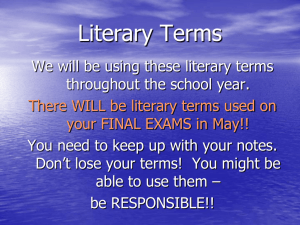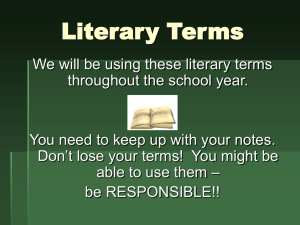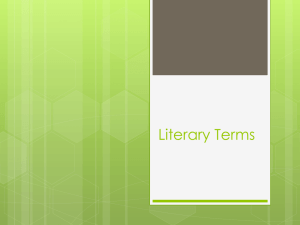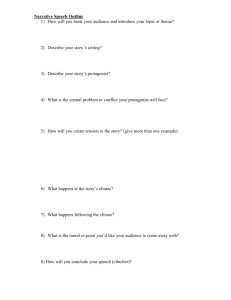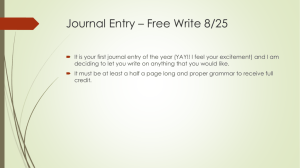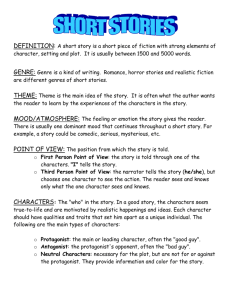Literary Terms
advertisement
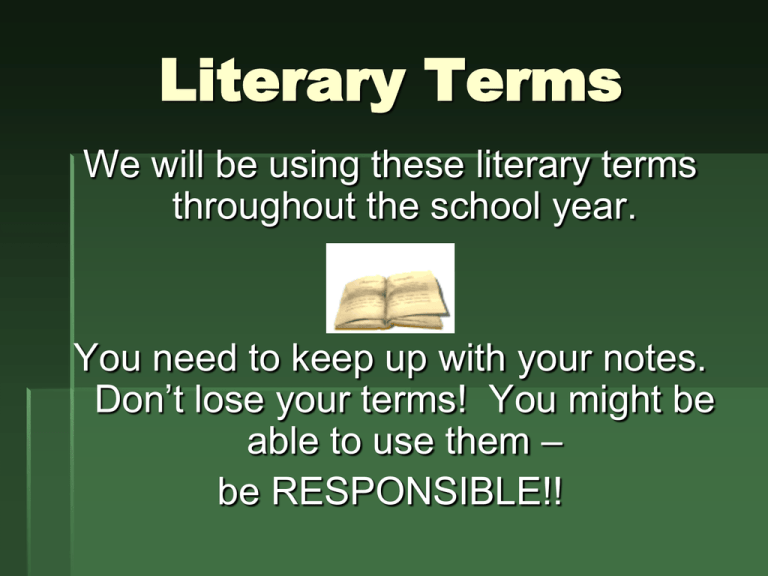
Literary Terms We will be using these literary terms throughout the school year. You need to keep up with your notes. Don’t lose your terms! You might be able to use them – be RESPONSIBLE!! We will use the following terms: Character Diction Imagery Exposition Falling Action Flashback Point of View Theme Metaphor Alliteration Irony Antagonist Denotation Mood Rising Action Resolution Foreshadowing Setting Tone Simile Onomatopoeia Inference Protagonist Connotation Poetry Devices Climax Conflict Suspense Mood Personification Oxymoron Hyperbole Character A character is a person or an animal that takes part in the action of a literary work. Edward Cullen from Twilight Shakespeare’s Queen of the faeries in A Midsummer Night’s Dream Harry Potter Wilbur from Charlotte’s Web Antagonist The Antagonist is a character or force in conflict with a main character, or protagonist. Do you know your Antagonists??? On your paper take a few minutes to write down some Antagonists that you can recall from movies, television shows, and video games Remember the Antagonist is in conflict with the Protagonist, or main character! Helpful hint – you should now know why people use the saying “Don’t antagonize me!” NAME THAT ANTAGONIST Antagonists can be anyone or anything that poses as an obstacle for the protagonist Protagonist The Protagonist is the main character in a literary work Can you name some famous Protagonists that are found in literature? Protagonists also come in all shapes, sizes, species, etc. Wilbur Ponyboy Curtis and the Greasers Jonas Catherine & Garfield Diction Diction is the manner in which we express words; the wording used. Diction = enunciation Some easy examples are: Don’t say ‘goin’ – say ‘going’, Don’t say ‘wanna’ – say ‘want to’ *Now, it’s your turn to provide some enunciation errors or slurs Denotation The denotation of a word is its dictionary meaning, independent of other associations that the word may have. Connotation The connotation of a word is the set of ideas associated with it in addition to its explicit meaning. The connotation of a word can be personal, based on individual experiences. More often, cultural connotations – those recognizable by most people in a group – determine a writer’s word choices. Denotation versus Connotation Some examples – Cheap is “low in cost” (denotation) but “stingy” or “poorly made” are the connotations of cheap Let’s use the word HOT The denotation (or dictionary definition – remember d in denotation = dictionary) of HOT is having a temperature higher than that of a human body. However, when you say “Man! He/She is hot!”, are you saying “Man! He is having a temperature higher than that of a human body!”? NO!!!!!!!!! You are saying the CONNOTATION of HOT – which could mean a variety of things – man he/she is cute, attractive, beautiful, and many other meanings – those come from personal experiences and cultural meanings, etc. Imagery Imagery is words or phrases that appeal to one or more of the five senses. Writers use imagery to describe how their subjects look, sound, feel, taste, and smell. EXAMPLES OF IMAGERY If you're tired and hopeless, how can you show someone this instead of just telling them? I took a walk around the world to Ease my troubled mind I left my body laying somewhere In the sands of time I watched the world float to the dark Side of the moon I feel there is nothing I can do --"Kryptonite" by Three Doors Down If you're a rapper, instead of telling someone to let your freestyles come naturally, how can you show them with your words? From the family tree of old school hip hop Kick off your shoes and relax your socks The rhymes will spread just like a pox Cause the music is live like an electric shock --Beastie Boys "Intergalactic" From Hello Nasty IMAGERY IN THE OLDEN DAYS “I Wandered Lonely As A Cloud” by William Wadsworth I wandered lonely as a cloud That floats on high o'er vales and hills, When all at once I saw a crowd, A host, of golden daffodils; Beside the lake, beneath the trees, Fluttering and dancing in the breeze. Continuous as the stars that shine And twinkle on the milky way, They stretched in never-ending line Along the margin of a bay: Ten thousand saw I at a glance, Tossing their heads in sprightly dance. The waves beside them danced; but they Out-did the sparkling waves in glee: A poet could not but be gay, In such a jocund company: I gazed---and gazed---but little thought What wealth the show to me had brought: For oft, when on my couch I lie In vacant or in pensive mood, They flash upon that inward eye Which is the bliss of solitude; And then my heart with pleasure fills, And dances with the daffodils. MOOD Mood, or atmosphere, is the feeling created in the reader by a literary work or passage. Writer’s use many devices to create mood, including images, dialogue, setting, and plot. Often, a writer creates a mood at the beginning of a work and then sustains the mood throughout. Sometimes, however, the mood of the work changes dramatically. **Edgar Alan Poe’s “The Tell-Tale Heart” emits a mood of terror based on the insanity of the murderous protagonist Plot Plot is the sequence of events. The first event causes the second, the second causes the third, and so forth. In most novels, dramas, short stories, and narrative poems, the plot involves both characters and a central conflict. The plot usually begins with an exposition that introduces the setting, the characters, and the basic situation. This is introduced and developed. The conflict then increases until it reaches a high point of interest or suspense, the climax. The climax is followed by the falling action, or end, of the central conflict. Any events that occur during the falling action make up the resolution. PLOTLINE Climax Resolution Exposition Conflict Introduced Exposition The Exposition is the introduction. It is the part of the work that introduces the characters, setting, and basic situation. ***In Harry Potter & the Sorcerer Stone, we quickly learn that Harry was turning 11, had a mysterious scar on his forehead, was living with his very disgruntled and burdened aunt, uncle, and bullying cousin due to the death of his parents when he was a baby. At the end of the exposition, we learn that he was the product of two wizard parents and on his way to entering Hogwarts. Rising Action Rising Action is the part of the plot that begins to occur as soon as the primary conflict is introduced. The rising action adds complications to the conflict and increases reader interest. Climax The Climax is the point of greatest emotional intensity, interest, or suspense in the plot of a narrative. On a plot diagram, it is the highest point due to how intense it is and immediately after the climax, there is a drastic drop in events leading to the resolution. The climax typically comes at the turning point in a story or drama. Falling Action Falling Action is the action that typically follows the climax and reveals its results. Resolution The Resolution is the part of the plot that concludes the falling action by revealing or suggesting the outcome of the conflict. Conflict Conflict is the struggle between opposing forces in a story or play. There are two types of conflict that exist in literature. External Conflict External conflict exists when a character struggles against some outside force, such as another character, nature, society, or fate. Person vs. Person Person vs. Society Person vs. Nature (environment) Person vs. Time Person vs. Supernatural Person vs. Technology (machine) NAME THAT CONFLICT Internal Conflict Internal conflict exists within the mind of a character who is torn between different courses of action. Questioning Having a Dilemma In a predicament What to Do? Example: Person vs. Self Man Versus Self Flashback A flashback is a literary device in which an earlier episode, conversation, or event is inserted into the sequence of events. Often flashbacks are presented as a memory of the narrator or of another character. Flashback continued… The movie Titanic is told almost entirely in a flashback. What are some other films that contain flashback to help tell stories? Holes Willy Wonka Think of some more… Foreshadowing Foreshadowing is the author’s use of clues to hint at what might happen later in the story. Writers use foreshadowing to build their readers’ expectations and to create suspense. This is used to help readers prepare for what is to come. Can you think of an element of foreshadowing? Suspense Suspense is the growing interest and excitement readers experience while awaiting a climax or resolution in a work of literature. It is a feeling of anxious uncertainty about the outcome of events. Writers create suspense by raising questions in the minds of their readers. Point of View Point of View is the perspective, or vantage point, from which a story is told. It is the relationship of the narrator to the story. First-person is told by a character who uses the first-person pronoun “I”. Third-person limited point of view is the point of view where the narrator uses thirdperson pronouns such as “he” and “she” to refer to the characters. Types of Third Person Limited: storyteller lets us know thoughts and feelings of main character (protagonist) only Omniscent: storyteller lets us know thoughts and feeling of all characters Setting The setting of a literary work is the time and place of the action. The setting includes all the details of a place and time – the year, the time of day, even the weather. The place may be a specific country, state, region, community, neighborhood, building, institution, or home. Details such as dialect, clothing, customs, and modes of transportation are often used to establish setting. In most stories, the setting serves as a backdrop – a context in which the characters interact. The setting of a story often helps to create a particular mood, or feeling. Style Style is the distinctive way in which an author uses language. Word choice, phrasing, sentence length, tone, dialogue, purpose, and attitude toward the audience and subject can all contribute to an author’s writing style. Theme The theme of a literary work is its central message, concern, or purpose. A theme can usually be expressed as a generalization, or general statement, about people or life. The theme may be stated directly by the writer although it is more often presented indirectly. When the theme is stated indirectly, the reader must figure out the theme by looking carefully at what the work reveals about the people or about life. Tone Tone is a reflection of a writer’s or speaker’s attitude toward a subject of a poem, story, or other literary work. Tone may be communicated through words and details that express particular emotions and that evoke and emotional response from the reader. For example, word choice or phrasing may seem to convey respect, anger, lightheartedness, or sarcasm. Figures of Speech A figure of speech is a specific device or kind of figurative language, such as hyperbole, metaphor, personification, simile, or understatement. Figurative language is used for descriptive effect, often to imply ideas indirectly. It is not meant to be taken literally. Figurative language is used to state ideas in vivid and imaginative ways. Metaphor A Metaphor is a type of speech that compares or equates two or more things that have something in common. A metaphor does NOT use like or as. Example: Life is a bowl of cherries. Simile A Simile is another figure of speech that compares seemingly unlike things. Simile’s DO use the words like, as, than, or resembles. Example: Her voice was like nails on a chalkboard. Oxymoron An Oxymoron is a figure of speech that is a combination of seemingly contradictory words. Examples: Same difference Pretty ugly Roaring silence Personification Personification is a figure of speech in which an animal, object, force of nature, or idea is given human qualities or characteristics. Example: Tears began to fall from the dark clouds. Alliteration Alliteration is the repetition of sounds, most often consonant sounds, at the beginning of words. Alliteration gives emphasis to words. Example: Peter Piper picked a peck of pickled peppers Alliterative Fun Caring Cats Caring cats cascade off Laughing llamas Lounging. Underneath yelling yaks Yelling at roaming Rats Rain Rain races, Ripping like wind. Its restless rage Rattles like Rocks ripping through The air. Irony Special contrast between reality and appearance Usually one in which reality is the opposite from what it seems Irony Situational-contrast between what would seem appropriate and what really happens or what we expect to happen is in fact quite opposite to what really does take place This is like a surprise ending or a twist in the plot that you didn’t expect. Irony Verbal-someone knowingly exaggerates or says one thing and means another Sarcasm is often verbal irony—We use this in our every day lives Example: “We try to be civilized here,” said General Zaroff. “The Most Dangerous Game” Irony Dramatic-When the reader or viewer knows something that a character does not know. Romeo and Juliet example Hyperbole An exaggeration Example: “enough food to feed a whole army” Fiction Imaginary elements Can be based on real people and events Realistic fiction/historical fiction Nonfiction Real events, people, and places Autobiography/biography Personal narrative/memoirs Newspapers Informative articles Inference A conclusion derived from facts/evidence Making an educated guess based on what you have read, learned, or know While reading a story, you may be able to infer something about the character based on what you have read in regards to his action, thoughts, viewpoints of others, etc.


